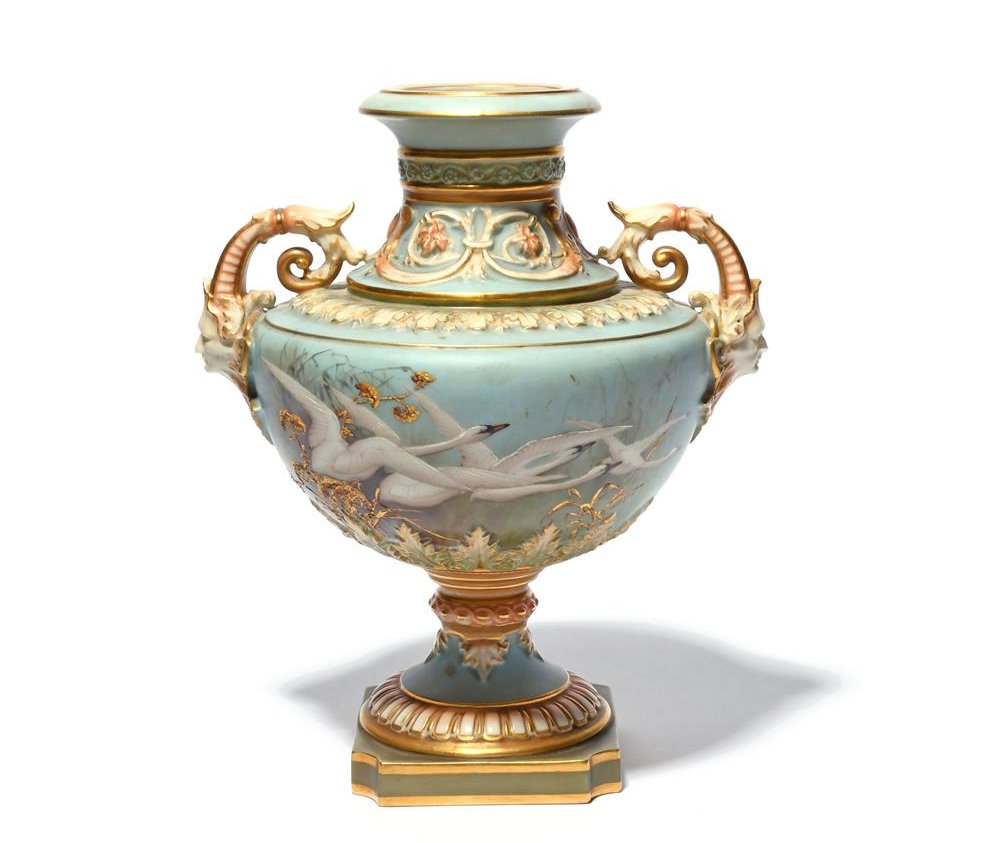Charles Henry Clifford Baldwyn, a name synonymous with the Royal Worcester Porcelain Company, carved a unique niche in the world of ceramic art through his exquisite bird paintings, especially his signature swan designs. His work not only exemplified artistic excellence but also played a pivotal role in defining the aesthetic direction of Royal Worcester in the late 19th and early 20th centuries.

Born in 1859 into a family with a musical background, Baldwyn’s creative inclinations were evident from a young age. Joining Royal Worcester at fifteen, his initial years involved mastering the foundational aspects of porcelain art. His dedication and talent soon saw him rise from performing menial tasks to specializing in the art form that would define his career – painting birds.

Baldwyn’s deep fascination with birds, particularly swans, was more than an artistic pursuit; it was a passion. He spent countless hours in the countryside, immersing himself in the study of local bird life. This commitment to realism and detail was reflected in his work, where each bird seemed to come alive on the porcelain canvas.
The Signature Swan Designs
At Royal Worcester, Baldwyn’s depiction of swans in flight became his hallmark. These designs were so distinctive and synonymous with his name that no other decorator at the factory was allowed to replicate them. It was this exclusivity and uniqueness that made his pieces highly sought after, both then and now.

In an era when artists rarely signed their work, Baldwyn was granted the privilege to sign his creations, a testament to his exceptional talent and the high regard in which he was held at Royal Worcester. His signatures, ‘C Baldwyn’ or ‘BY’, on a piece, signify its authenticity and add to its collectible value. While best known for his swan paintings, Baldwyn’s repertoire included a variety of birds, from pigeons and owls to exotic tropical species. His versatility also extended beyond porcelain, as he was a skilled watercolourist. His works were exhibited at prestigious venues like the Royal Academy, further cementing his status as a multifaceted artist.

The late 19th and early 20th centuries were not without challenges. Economic downturns affected luxury goods sales, including porcelain. Baldwyn, like many artists of the time, supplemented his income through private commissions and sales. His dedication during these testing times demonstrated his commitment to his craft. Baldwyn’s influence extended beyond his tenure at Royal Worcester. His departure in 1904 did not diminish the popularity of his designs. The factory, recognizing the enduring appeal of his work, registered his designs to prevent imitation. However, post-departure, adaptations of his swan designs were created by other artists at the factory, a testament to his lasting impact. Baldwyn’s personal life was marked by both joy and tragedy. His marriage to Emily Hughes in 1897 and the friendships he fostered, notably with fellow artist William Hawkins, highlighted the joyous aspects. However, the loss of his children, Stella and Bernard, added a sombre note to his life story.
Charles Henry Clifford Baldwyn’s legacy at Royal Worcester is more than a collection of exquisite bird paintings. It is a story of dedication, passion, and resilience in the face of changing times. His work remains a high point in the history of British porcelain art, celebrated for its artistic excellence and the unique lens through which he viewed the natural world. As a master of avian artistry, Baldwyn’s creations continue to inspire and captivate collectors and art enthusiasts worldwide.
Related
The Doughty Sisters – Freda and Dorothy





